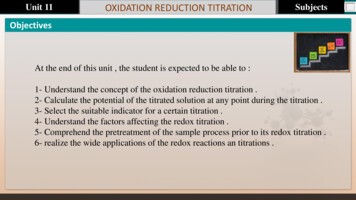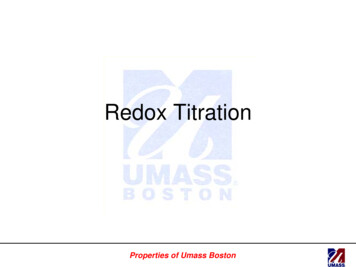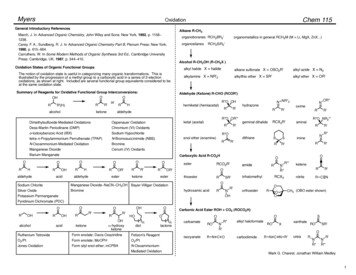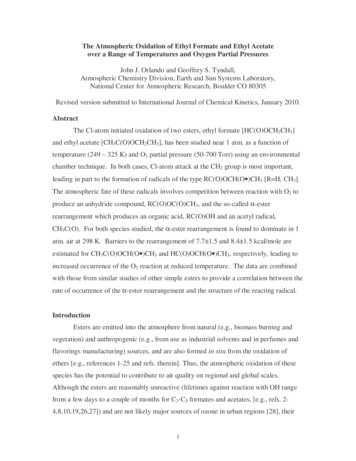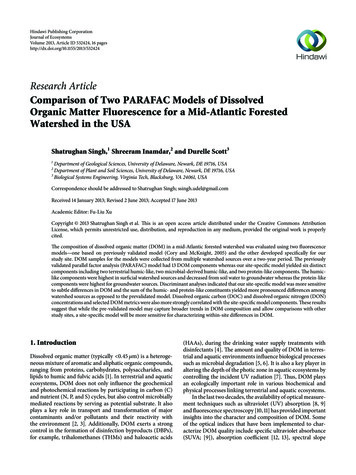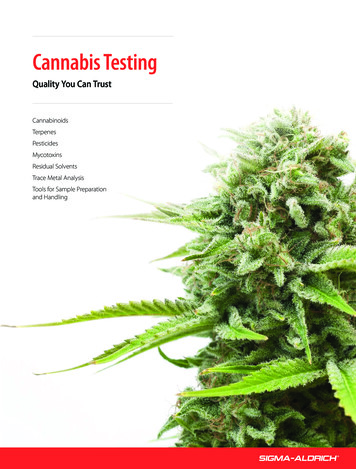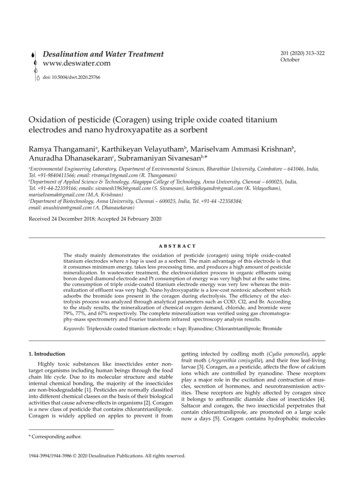
Transcription
Desalination and Water Treatmentwww.deswater.com201 (2020) 313–322Octoberdoi: 10.5004/dwt.2020.25766Oxidation of pesticide (Coragen) using triple oxide coated titaniumelectrodes and nano hydroxyapatite as a sorbentRamya Thangamania, Karthikeyan Velayuthamb, Mariselvam Ammasi Krishnanb,Anuradha Dhanasekaranc, Subramaniyan Sivanesanb,*aEnvironmental Engineering Laboratory, Department of Environmental Sciences, Bharathiar University, Coimbatore – 641046, India,Tel. 91-9840411566; email: rtramya1@gmail.com (R. Thangamani)bDepartment of Applied Science & Technology, Alagappa College of Technology, Anna University, Chennai – 600025, India,Tel. 91-44-22359166; emails: sivanesh1963@gmail.com (S. Sivanesan), karthikeyandv@gmail.com (K. Velayutham),mariselvamak@gmail.com (M.A. Krishnan)cDepartment of Biotechnology, Anna University, Chennai – 600025, India, Tel. 91-44 -22358384;email: anushivan@gmail.com (A. Dhanasekaran)Received 24 December 2018; Accepted 24 February 2020abstractThe study mainly demonstrates the oxidation of pesticide (coragen) using triple oxide-coatedtitanium electrodes where n hap is used as a sorbent. The main advantage of this electrode is thatit consumes minimum energy, takes less processing time, and produces a high amount of pesticidemineralization. In wastewater treatment, the electrooxidation process in organic effluents usingboron doped diamond electrode and Pt consumption of energy was very high but at the same time,the consumption of triple oxide-coated titanium electrode energy was very low whereas the mineralization of effluent was very high. Nano hydroxyapatite is a low-cost nontoxic adsorbent whichadsorbs the bromide ions present in the coragen during electrolysis. The efficiency of the electrolysis process was analyzed through analytical parameters such as COD, Cl2, and Br. Accordingto the study results, the mineralization of chemical oxygen demand, chloride, and bromide were79%, 77%, and 67% respectively. The complete mineralization was verified using gas chromatography-mass spectrometry and Fourier transform infrared spectroscopy analysis results.Keywords: Tripleoxide coated titanium electrode; n hap; Ryanodine; Chlorantrianiliprole; Bromidegetting infected by codling moth (Cydia pomonella), applefruit moth (Argyresthia conjugella), and their free leaf-livingHighly toxic substances like insecticides enter non- larvae [3]. Coragen, as a pesticide, affects the flow of calciumtarget organisms including human beings through the foodions which are controlled by ryanodine. These receptorschain life cycle. Due to its molecular structure and stableplay a major role in the excitation and contraction of musinternal chemical bonding, the majority of the insecticidescles, secretion of hormones, and neurotransmission activare non-biodegradable [1]. Pesticides are normally classifiedities. These receptors are highly affected by coragen sinceinto different chemical classes on the basis of their biologicalit belongs to anthranilic diamide class of insecticides [4].activities that cause adverse effects in organisms [2]. CoragenSaltacor and coragen, the two insecticidal perpetrates thatis a new class of pesticide that contains chlorantrianiliprole.contain chlorantraniliprole, are promoted on a large scaleCoragen is widely applied on apples to prevent it fromnow a days [5]. Coragen contains hydrophobic molecules1. Introduction* Corresponding author.1944-3994/1944-3986 2020 Desalination Publications. All rights reserved.
R. Thangamani et al. / Desalination and Water Treatment 201 (2020) 313–322314that bind extensively to biological membranes, especiallyphospholipid bi-layers, and damage membranes by inducing lipid peroxidation [6–8]. Further, it produces long-termill effects in marine organisms. The above discussed environmental ill-effects of coragen raise concerns about addressingthe pollution it causes. Various technologies and processessuch as hydrogen peroxide extraction, UV, ultrasonic radiation, and biodegradation have been proposed for coragen treatment. However, these methods are deemed to beunsuitable to treat highly-concentrated industrial effluents.As a result, ecofriendly methods like the electrochemicaltreatment process have become one of the prominent areasof research in recent years for wastewater treatment process [9,10]. During the oxidation process, the organic substances which are present in wastewater can be oxidizedin two common ways such as direct oxidation and indirectoxidation. Direct oxidation occurs at the anode surface andproduces H2O and CO2. Indirect oxidation occurs in thepresence of strong oxidants such as chlorine, hypochlorite,peroxydisulfate, and ozone to finally produce H2O and CO2.1.1. Electro-oxidationThe mechanism of electrochemical oxidation of waste water is a complex phenomenon that involves the couplingof electron transfer reaction with a dissociates chemisorption step. In general, two different processes occur at theanode; one is the anode with high electro-catalytic activity, where oxidation occurs at the electrode surface (directelectrolysis) whereas, in metal oxide electrode, the oxidation occurs via a surface mediator on an anodic surfacewhere they are generated continuously (indirect electrolysis). In direct electrolysis, the rate of oxidation dependsupon electrode activity, the diffusion rate of pollutants,and current density. On the other hand, temperature, pH,and diffusion rate of the generated oxidants determinethe rate of oxidation in indirect electrolysis. In indirectelectro- oxidation, the chloride salts of sodium or potassiumare added to the wastewater for better conductivity andgeneration of hypochlorite ions.The reactions of anodic oxidation of chloride ions thatproduce chlorine are given below:2Cl Cl 2 2e (1)The liberated chlorine forms the hypochlorous acidCl 2 H 2 O H Cl HOCl(2)and further gets dissociated to yield hypochlorite ionHOCl 3H OCl at anode surface to produce adsorbed hydroxyl radicalsaccording to the following reaction:MO x H 2 O MO x ( OH ) H e The adsorbed hydroxyl radicals interact with oxygenwhich is already present in the oxide-coated anode. The transition of oxygen from adsorbed hydroxyl radicals produceshigher oxide MOx 1.MO x( )OH MO 1 H e xThe OCl– acts as the main oxidizing agent in the wastewater treatment process.The generated hypochlorite ions act as the main oxidizing agent in the degradation of pollutants. The directelectrooxidation rate of degrading the organic pollutantsmainly depends on the anode surface and the applied powerdensity. The anodic reactions are given below. H2 is ejected(5)Active oxygen is normally present in two states on anodesurface that is, either as hydroxyl radicals or oxygen in thelattice. In the absence of any oxidizable organics, the ‘activeoxygen’ produces dioxygen as per the following reactions:MO x ( OH ) MO x 1 2 O 2 H e (6)MO x1 MO x 1 2 O 2(7)When using sodium chloride as the supporting electrolyte, the chloride ion reacts with hydroxyl radicals to formadsorbed hypochlorite radicals for which the reactions aregiven below:MO x( )OH Cl MO x ( Cl ) H 2e (8)The adsorbed hypochlorite radicals may interact withoxygen present in the surface anode to form adsorbed hypochlorite radicals according to the following reactions:MO x( MO x( )(9))(10)OC Cl MO 1 Cl 2 e xOCl Cl MO x 1 2 O 2 1 2 Cl 2 e In the presence of oxidizable organics, the physisorbedactive oxygen’ ( OH) should completely combust the organics so that the chemisorption participates in the formation ofselective oxidation products (27) according to the followingreactions:12R MO x( )OH 1 2 ROO H e MO xR MO x1 RO MO x(3)(4)(11)(12)This study focused on studying the degradation rate ofcoragen-contaminated wastewater using triple oxide-coatedtitanium anodes and sorbent nano-hydroxyapatite. The efficiency of electrocatalytic oxidation was assessed throughanalytical parameters such as chemical oxygen demand(COD), chloride, and bromide. The total degradation ofcoragen was strongly proved through gas chromatography–mass spectrum and Fourier transform infrared (FTIR)spectroscopy.
R. Thangamani et al. / Desalination and Water Treatment 201 (2020) 313–3223152. Materials and methods2.3. Parameters2.1. Electrode materialsThe open reflex method was used to analyze the CODaccording to the standard methods (5220 A) (APHA 1995)[11]. Chloride was estimated as per Mohr’s method (4500B-Cl; Argentometric method) and bromide was estimated by the colorimetric method (APHA 4500) using aspectrophotometer at 610 nm.Titanium tantalum products which provide triple oxidecoated titanium electrodes, with a coating thickness of 6mm,were chosen for the study. The monopolar connection wasused in this study. The triple oxide-coated titanium electrode acts as anode whereas the other triple oxide coatedelectrode acts as a cathode. The coating consists of tripleoxide coated titanium electrodes namely Pt, Ir, and Ta with20, 20, and 10 g/m2. The triple oxide-coated electrodes haveexcellent specific electrolytic properties. These electrodes areactive in different types of atmospheric conditions including high and low pH, high concentration of Cl2, and hightemperature. Triple oxide-coated titanium electrodes with adimension of 10 mm 10 mm 2.5 mm were used in thestudy. The hydrothermal method was followed to preparenano-hydroxyapatite whereas the morphology, functionalgroups, and the surface area of n hap were identified usingscanning electron microscopey (SEM), FTIR, and X-raydiffraction (XRD) instruments.2.4. Characterization of nano-hydroxyapatiteThe (SEM, Hitachi-S4800, 16-1, Higashiueno 2-chome,Taito-ku, Tokyo, 110-0015 Japan) was used to analyze theexter nal features of the n hap whereas FTIR (Perkin Elmer,USA) was used to study the functional bonds of n hap. Thepowdered form of n hap was recorded with FTIR spectra.X’PERT PRO (The Netherlands) PAN analytical X-raydiffractometer was used to analyze the XRD (Figs. 2–4).2.2. Analytical methodsA sample container of 250 mL volume was placedon a magnetic stirrer. The concentration of coragen was1,000 ppm whereas the effluent volume taken was 200 mLwith 2.5 mg L–1 NaCl concentration. To change the pHs of theeffluent, 0.1 NaCl, 0.1 HCl solution, and triple oxide-coatedelectrode were placed on the top of the sample container withan inter-electrode gap of 2 cm. The surface area of the triple oxide-coated electrode was 617 cm2. Rectifier DC powersupply was connected to supply electric current during electrolysis. The DC rectifier was equipped with a digital ammeter and voltmeter which were linked to a stabilized electricpower. Particular time interval-treated effluents were alsocollected simultaneously. The effluent was well mixed bymagnetic stirrer (Fig. 1).Fig. 2. SEM image of hydroxyapatite.1.02926.40% 001035.76350030002500200015001000500Wavelength Cm-1Fig. 1. Schematic representation of the EOP experimental setup.Fig. 3. FTIR image of hydroxyapatite.
R. Thangamani et al. / Desalination and Water Treatment 201 (2020) 313–322316500100211pH3400pH580pH9300102200202% of COD RemovalCounts A.UpH7212222604010020020406080Angle (degree)0010203.1. Various pHs on CODIn the electrolysis of wastewater, pH is one of theprimary key parameters. The total mineralization of coragen during electrolysis using triple oxide-coated titanium electrodes was tested by changing the pH from 3to 9. During electrolysis, triple oxide-coated titaniumwas used as an electrode besides using the electrolyte of2.5 mg L–1 concentration with a power density of 2.5 mAcm–2. For every five mins, treated coragen samples werecollected and tested for COD. Fig. 5 represents the pH ofCOD mineralization. When compared with other pHs suchas 3, 7, and 9 (38% and 40%), it was found that the pH 5attained the maximum COD mineralization (58%). At pH5, the major active substance was (HClO–) and at alkalinemedium, the major active substance was ClO– ions [12].The hydroxyl radicals were produced in a better manner inacidic medium, due to the front side of Cl– ion at a higherlevel in acidic medium. Earlier reports have already provedthat under pHs 2, 3, and 5, the majority of the substanceswere hypochlorous acid (HOCl) and hypochlorite (OCl–)ions [13]. At alkaline and neutral medium, the instabilityof OH causes less mineralization rate.3.2. Various pHs on ChlorideDuring the electrolysis process, pH causes a chemicalreaction of the oxidant in an electrolyte (NaCl). The chloride was removed at four different pH values such as 3,5, 7, and 9. During the electrolysis, the oxidation occurson the front side of Cl– ions as shown (Eqs. (13)–(16)).The speciation equation for active chlorine species (Cl2,Cl3–, HClO, and ClO–) was calculated at the time of electrolysis of 2.5 mg L–1 NaCl for Cl–. The Cl3– got producedin very low concentrations of pH 3.0, while the predominant species was Cl2 until the pH was 5.0 whereas theHClO was in the pH range of 3–9 and it was pH 9.0 incase of ClO–. The mediated oxidation of coragen, withthese species, was then expected to be faster in the acidicmedium than alkaline medium because of the high standard potential of Cl2 (E0 1.36 V) and HClO (E0 1.49) in40506070Time (min)Fig. 4. XRD image of hydroxyapatite.3. Result and discussion30Fig. 5. Various pH on COD.comparison with ClO– (E0 0.89 V). Since most electrolyticprocesses in undivided cells occur in acidic medium, thegeneral mineralization of pesticide is commonly referred toas follows, which remains the only chemical action of ClO–.2Cl Cl ( a ) 2e ( Standard potential of Cl 2 ) ( E0 1.40 V ) (13)Cl 2 H 2 O HOCl H Cl ( E0 of HOCl 1.49 V )(HOCl H OCl E0 of ClO 0.89 V)Coragen OCl Intermediates CO 2 H 2 O Cl (14)(15)(16)To change the pH, the equilibrium was operated in thereaction (Eq. (15)), while the HOCl substance was dominantin acidic pH. The hypochlorite ions (ClO–) were the majorsubstances when pH was above 9. At acidic pH, as shownin Fig. 6, the hypochlorous acid ions and chloride ions werestrongly controlled by the oxidation process. The final resultsshow that the maximum Cl2 removal (65%) was obtainedat pH 5.3.3. Various pHs on bromideBromide toxicity tremendously affects human beingsdue to which the maximum permissible limit of bromideconcentration is 25 µg L–1 [14–19]. Chlorotrianlipore contains bromide in its chemical structure. Heavy metals cannot be removed through oxidation due to which the currentstudy applied n hap as an adsorbent to remove bromide.The bromide was observed in high quantities at pH 3 (59%).At low pH, the n hap surface produces huge volumes of H ions. In n hap, the adsorbed surface becomes neutral therebyremoving the hindrance to the diffusion of bromide ions.At high pH values, the reduction in adsorption is possibledue to the presence of abundant OH– ions causing increasedhindrance to the diffusion of bromide ions. The efficiency ofthe nano-hydroxyapatite material, using different pHs, as
R. Thangamani et al. / Desalination and Water Treatment 201 (2020) 313–322100317100pH380pH3pH5pH7pH980pH5pH9% of Bromide Removal% of Chloride RemovalpH760404020200010203040506070Time (min)Fig. 6. Various of pH on chloride.compared with previous studies [20–23]. The removal efficiency of heavy metal-like fluoride was very high at acidicpH [72% at pH 5, 69% at pH 3, 95% at pH 6, and 86% at pH 4].This was because, at low pH conditions, the H ions dominatethe other ions. The result is shown as a graph with valuesplotted in Fig. 7. The bromide removal got increased at both7 and 9 pH range because of the presence of hydroxyl ions.The OH– hinder the diffusion of bromide ions. Fig. 7 inferredthat the maximum removal of bromide was achieved at pH 3.3.4. Various power densities on CODThe electrolysis rate is mainly controlled by power density [24–26]. To optimize the influence of power compactnesson coragen removal, three different power densities wereused such as 2.5, 5.0, and 7.5 mA cm–2 whereas 200 mg L–1 ofcoragen effluent was treated using triple oxide electrodes atvarious power compactness. The results obtained are shownin Fig. 8. As illustrated, when the current was increasedfrom 2.5 to 7.5 mA cm–2, the percentage of COD removal gotincreased to 79% for triple oxide-coated titanium anodeswith n hap sorbent. It has been emphasized in earlier reportsthat the rate of mineralization increases when various powercompactness’ are used. In comparison with other studies,power density plays a vital role in the removal of COD.The rate of COD removal got increased when the currentdensity was increased. Lidia et al. [35] mentioned that highpower compactness, throughout the electrolysis process,increases the generation of chlorine which is mainly responsible for the removal of pollutants from coragen [27–30] (Fig. 8).3.5. Various power densities on chlorideCl2 mineralization was similar to cathodic protectionwhere the direct power was extended into RuO2 /IrO2/TaO2coated titanium electrodes though there are two major differences noticed. The first difference is the temporary aspectof the surface anode for chloride removal which existedonly during the process duration and the second difference is the higher extent power which was utilized in the010203040506070Time (min)Fig. 7. Various of pH on bromide.1002.5 mA5.0 mA7.5 mA80% of COD Removal0606040200010203040506070Time (min)Fig. 8. Various Power density on COD.Table 1Some important functional groups assignments of hydro xyapatite nanoparticlesWavenumberStretching modeFunctional group3,567.701,693.32634.891,035.76565.70Ion stretching groupCarboxylatesAlkyl halidesPolysaccharidesAlkyl halidesOH–CO2CBrCOCBrremoval of Cl2 compared to cathodic protection. Power levels were decided to be practical for Cl2 removal in the rangeof 2.5–7.5 mA cm–2. For the removal of chloride, the samevolume of power was utilized, but a minimum time periodwas enforced. The electrolysis processes were carried out forabout 70 min under the room temperature of 25 C at pH 5using a triple oxide-coated titanium electrode with an initialconcentration of 1,000 mg L–1 coragen and 2.5 mg L–1 NaCl.
R. Thangamani et al. / Desalination and Water Treatment 201 (2020) 313–322318The electrode gradation was carried out at optimum powercompactness of 7.5 mA cm–2. At this value, there was a greatpossibility of an electro generation of Cl2 in solution. At highpower compactness, the production of hypochlorite ionswas high. Maximum mineralization of chloride (77%) wasobtained at the highest power compactness of 7.5 mA cm–2within 70 min at pH 5 as shown in Fig. 9.3.6. Various run times on CODDuring coragen electrolysis, the consumption of pow er is an important test so that it has been conducted withdifferent run times. The removal of chemical oxygendemand got increased with increased run time. The coragenremoval got increased from 30 to 150 min impulse whichwas directly proportionate to the run time. The mineralization of COD was effective at the starting of electrolysiswhereas the gradual value was later maintained at the endof electrolysis. The experiments were carried out for thepercentage of COD removal with the operation run time of30–150 min at constant power compactness of 2.5 mA cm–2with NaCl concentration of 2.5 mg L–1 and constant pH 5.Fig. 10 represents the rate of COD mineralization whichgot increased with run time. It clearly mentioned that thecoragen mineralization was directly proportional to run time.coragen is primarily dependent on (Na ) anion of the NaClpresent in the effluent. The Cl– cation got converted intochloride (Cl2). This is the reason behind the estimation ofchloride ion concentration in the current study after the electrolysis of the samples. The power compactness of 2.5 mAcm–2, constant pH of 5, run time of 150 min, and the NaClof 2.5 g concentration were maintained during the electrolysis (Fig. 11). According to the previous report publishedby Velstich et al. [36] a firm catalytic action of Cl2 ion wasnoticed during the transition of organic pollutants to innocent carbon dioxide and water in the presence of chlorideion. According to the study published by Bhaskar Raju et al.[37] a firm catalytic action of Cl2 ion was noticed during thetransition of organic pollutants to innocent carbon dioxideand water in the presence of chloride ion.3.8. Various run times on bromideVarious run times on the remotion of bromide usingnano-hydroxyapatite were analyzed. The run time curves,given in Fig. 12, show rapid adsorption of bromide from100% of COD RemovalThe wastewater run time is an essential factor for electrolysis processes. In common, larger run time increasesthe efficiency of electrolysis [31]. Various supporting electrolytes, on the mineralization of coragen, were examinedin the presence of supporting electrolytes such as NaCl.Electrolyte concentration is one of the important factors inwastewater treatment that make use of the electrooxidationprocess. Previous studies proved that increasing the concentration of electrolytes favors the degradation of organicmaterial rate [32–35]. In the current study, sodium chloridewas used as an electrolyte. NaCl got split into Na anion andCl– cation during electrolysis. The complete mineralization of60402000306090120150Time (min)Fig. 10. Various run time on COD.1002.5 mA5.0 mA7.5 mA80100150 min8060% of Chloride Removal% of Chloride Removal150 min803.7. Various run times on chloride40200604020010203040Time (min)Fig. 9. Various power density on chloride.50607000306090Time (min)Fig. 11. Various run time on chloride.120150
R. Thangamani et al. / Desalination and Water Treatment 201 (2020) 313–3221.0100150 min0.91298.9 1039.8624.70.860% of Transmittance% of Bromide 01500.14000Time (min)350030002500200015004. FTIR analysisTo determine the changes that had occurred in the functional group during electro-oxidation, the samples weremonitored using FTIR spectroscopy. The experiments wereconducted under optimal conditions except for the timeduration which was fixed as 20 min. The 150 min treatedcoragen sample which had a pH of 5 with a power density of 7.5 mA cm–2 was used to analyze the FTIR analysis.Figs. 13 and 14 show the IR spectra of the carriage before andafter the electrolysis at room temperature. The characteristic peaks of the coragen effluent (Table 1) at 3,356 cm–1 weredue to the primary, secondary amines, and amides presentin raw coragen effluent. The peaks found at 2,127; 1,640;and 1,369 cm–1 were mainly due to the stretching absorption of alien and carbonyls (general) groups. Besides, thepeaks were obtained at 1,233; 661.05; and 597.58 cm–1 dueto the alkyl halide C–Br stretch gojolroups respectively.500Fig. 13. FTIR image for before electrolysis of coragen.1.00.91012.40.8% of Transmittance150 min, and the bromide ions get accumulated withincreased run time which makes it saturated to diffusedeeper into the adsorbent structure at the highest energysites. This was attributed to the reason that the mesoporesget filled up which resists in the diffusion of aggregated bromide molecules in the adsorbents [38]. Different run timeswere tested to optimize the electrolysis of coragen effluent.Five various run times were carried out for bromide removal(30, 60, 90, 120, and 150 min). At constant power compactness of 7.5 mA cm–2, NaCl concentration of 2.5 mg L–1 andat optimum pH 3 as shown in Fig. 12, there was an increasein bromide adsorption when the run time increased. In theliterature, it is proven that the increase in contact time, onecan achieve high removal efficiency. Likewise, in the currentstudy, the researcher achieved the maximum Br removalefficiency by increasing the run time. [39–41]. In the presenceof n hap, the maximum mineralization of Br was achievedat 60 min of run time. The adsorption percentage of Br was62% with power compactness of 7.5 mA cm–2 in 60 min runtime. The final results represent that the bromide desorptionis directly proportional to run time.1000Wavelength cm-1Fig. 12. Various run time on 00200015001000500-1Wavelength cmFig. 14. FTIR image for after electrolysis of coragen.5. Gas chromatography–mass spectrometry(GC-MS) analysisThe intermediate species, formed during the mineralization of corrosion, using triple oxide-coated titaniumanode were identified by GC–MS (Perkin Elmer-Clarus 600,Germany). The samples that underwent the electro-oxidation process at 5 min time intervals were collected duringthe electrolysis of all the samples. Through GC–MS (PerkinElmer-Clarus 600, Germany), with MS capillary column(60 µm 250 µm), an intermediate analysis was carried out.In this analysis, a constant flow rate of 1 mL min–1 heliumwas used as a carrier gas. The temperature of the ion sourcewas 200 C. The initial oven temperature was maintained at50 C for 5 min and the range of scan mode was m/z from40 to 480 Da. The injection volume was 5 µL and under theseoperating conditions, the retention time for standard coragenwas 17.40 min. After 60 min, the electrolysis samples were
320R. Thangamani et al. / Desalination and Water Treatment 201 (2020) 313–322Table 2Comparison of different electrode potential for removal of pollutantsElectrodePollutantsOptimumpHEC% of COD ReferenceremovalTriple oxide coatedtitanium electrodeSilicon-based solar cellBoron doped diamond electrodeBoron doped diamond electrodeBoron doped diamond electrodeBoron doped diamond electrodePtPtPtCoragen57.5 mA cm–278.0%In this studyOrganic pollutantsPesticideMunicipal itrant indole–3.03.03.03.03.03.08.61.6 V100 mA cm–2196 A m–2400 mA8.0 mA cm–21.000 mA40.0 mA161 A m–256.0%100.0%100.0%80.0% 86.0% 96.0%80.0%86.3%Perez-Rodriguez et al. [42]Vieira Guelfi et al. [43]Garcia-Segura et al. [44]Korbahti et al. [45]Zazoua et al. [46]Luo et al. [47]Luo et al. [47]Hiwarkar et al. [48]analyzed for intermediates. It is necessary to discuss therole played by electrocatalyst and oxidation in the removalof COD, chloride, and bromide which are mainly attributedto the radicals and this is mainly due to electrooxidationgeneration of oxidant species (OH , H2O2, HOCl–, and OCl–depending on the pHs). As shown in Table 2, the by- productswere detected at 5 min and at pH 5 for the electrolysis process. As given in Fig. 16, after 5 min of the oxidation process, major fragments got generated in the removal process.The mineralization of the pesticide and electrolysis causessignificant mineralization which results in the formation ofsubstitutes such as (Figs. 15 and 16) boxylic acid, 2,6-dichloro-4methyl-11H-pyrido )-6 [(methylamino)carbonyl] xamide,2Amino-5-Fig. 15. GC image of coragen.chloro-3(methylamino) carbonyl] benzoic acid, 2-[3-Bromo1-(3-chloro-2-pyridinyl) 2–3-Nitro-1 bromide , 2–3-Nitro-1 bromideand other lower molecular compounds.6. ConclusionThe electrochemical treatment of the simulated syntheticwastewater containing pesticides (coragen) has been investigated under several operating conditions using a tripleoxide-coated titanium electrode. The highest electrocatalytic activity was observed at applied power compactnessof 7.5 mA cm–2 under optimum pH 5 and supporting NaClof 2 mg L–1 concentration. The maximum removal efficiencies of coragen under optimum condition were COD, Cl,and Br 79%, 77%, and 59%. In the present investigation, it isconcluded that the use of a triple oxide-coated titanium electrode and nano-hydroxyapatite (n hap) in the electrocatalyticFig. 16. MS image of coragen.
R. Thangamani et al. / Desalination and Water Treatment 201 (2020) 313–322degradation played a major role. The GC–MS and FTIRresults have proved that some organic compounds (coragen)led to maximum degradation. So these electrodes and n hapcould be applied in the treatment of agricultural wastewatersthat contain organic compounds such as 0][11][12][13][14][15][16][17][18][19][20]E. Vangelie, R. Campos, J. Luiz de Oliveira, L. Fernandes,Fraceto, B. Singh, Polysaccharides as safer release systems foragrochemicals, Agron. Sustainable Dev., 3 (2015) 47–66.A. Özkara, D. Akyıl, M. Konuk, Pesticides, EnvironmentalPollution, and Health, Elsevier, (2016), doi: 10.5772/63094.A.K. Mishra, V.K. Chandiraseharan, N. Jose, T.D. Sudarsanam,Chlorantraniliprole: an unusual insecticide poisoning in humans,Indian. J. Crit. Care. Med., 20 (2016) 742–744.J. Bartlomiej, S. Troczka Martin, M. Williamson Linda, T.G. EmyrDavies, Rapid selection for resistance to diamide insecticidesin Plutella xylostella via specific amino acid polymorphisms inthe ryanodine receptor, Neurotoxicology, 60 (2017) 224–233.Y. Liu, Y. Gao, G. Liang, L. Yanhui, Chlorantraniliprole as acandidate pesticide used in combination with the attracticidesfor lepidopteran moths, PLoS One, 12 (2017) 1–10, doi: org/10.1371/journal.pone.0180255.K. Dutta, M. Ali, A. Najam, R. Kumarand, A. Kumar,Ameliorative effect of seed extract of Pterocarpus santalinuson coragen induced haematological alterations and serumbiochemical changes in charles foster rats, J. Toxicol. Environ.Health, 6 (2014) 194–202.H. Watson, Biological membranes, Essays Biochem., 59 (2015)43–69.A. Catala, Lipid peroxidation modifies the assembly ofbiological membranes the lipid whisker model, Front. Physiol.,5 (2015) 1–4, doi: 10.3389/fphys.2014.00520.O. Ganzenko, D. Huguenot, E.D. Van Hullebusch, G. Esposito,M.A. Oturan, Electrochemical advanced oxidation and bio log
O and CO 2. Indirect oxidation occurs in the presence of strong oxidants such as chlorine, hypochlorite, peroxydisulfate, and ozone to finally produce H 2 O and CO 2. 1.1. Electro-oxidation The mechanism of electrochemical oxidation of waste-water is a complex phenomenon that invol

